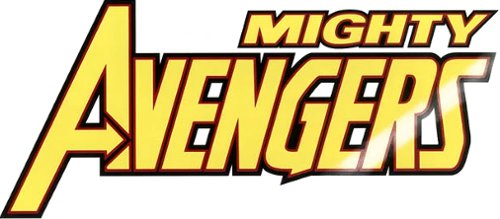FF (2nd series) – (2013-2014)
For She-Hulk’s second stint on the Fantastic Four, she was part of the spin-off title FF, short for Future Foundation. This was written by Matt Fraction in conjunction with his run on the main Fantastic Four title. Both series lasted 16 issues in which the premise entailed the main team 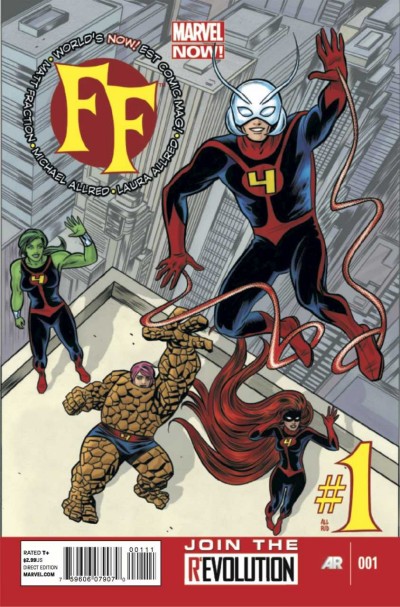 going on a cosmic adventure in space while a group of four replacement heroes took over the Earth-based duties of the team. Originally, the fill-in team was put in place under the assumption that they would be doing it for only four minutes but this timetable failed to hold when the original team did not return as scheduled. Thus, She-Hulk found herself on a team led by Scott Lang’s Ant-Man, along with queen of the Inhumans Medusa and Johnny Storm’s latest girlfriend Darla Deering as the She-Thing.
going on a cosmic adventure in space while a group of four replacement heroes took over the Earth-based duties of the team. Originally, the fill-in team was put in place under the assumption that they would be doing it for only four minutes but this timetable failed to hold when the original team did not return as scheduled. Thus, She-Hulk found herself on a team led by Scott Lang’s Ant-Man, along with queen of the Inhumans Medusa and Johnny Storm’s latest girlfriend Darla Deering as the She-Thing.
The book’s tone was humorous and exemplified by the quirky art of Mike Allred, who drew almost every issue of the short-lived series. His art style was very cartoony with a lot of exaggeration and weirdness on the page. This was not a style foreign to She-Hulk books and, while She-Hulk was not a major focus of most of the stories, her personality certainly fit the tone of the book. The stories were classic FF style adventures but placed much of the focus on the dozen or so super children placed in the Foundation’s care.
Of these children were four intelligent Moloids that quickly developed a crush on She-Hulk and became highly jealous when Wyatt Wingfoot entered her life yet again. Issue #4 saw the most  She-Hulk centered story, in which the Moloid children attempt to disrupt a get together between the pair of former lovers. While Jen protested often that it was not a date, every attempt at sabotage by the Moloids led to a more romantic setting. This eventually had Jen and Wyatt admitting that no one they had dated since breaking up had come close to measuring up to their former relationship. They appeared to start dating again but, like many other times throughout She-Hulk’s history, the looseness and ending of their renewed relationship was unclear.
She-Hulk centered story, in which the Moloid children attempt to disrupt a get together between the pair of former lovers. While Jen protested often that it was not a date, every attempt at sabotage by the Moloids led to a more romantic setting. This eventually had Jen and Wyatt admitting that no one they had dated since breaking up had come close to measuring up to their former relationship. They appeared to start dating again but, like many other times throughout She-Hulk’s history, the looseness and ending of their renewed relationship was unclear.
Other defining characteristics during this time period included a distrust of Medusa that at one point led to a full on brawl between the two strong-willed women. She also bonded a bit with Darla who had started a relationship with the FF’s new leader Scott. However, She-Hulk was mostly a team player during this period and went along with Scott’s plans to take down Dr. Doom in the interest of protecting the children, despite Scott’s personal vendetta against the man. Eventually, the original team returned from their extended journey and She-Hulk’s time with the FF again ended.
| Writers | Artists |
|---|---|
|
|
Mighty Avengers (2nd series) - (2013-2014)
She-Hulk came into the roster of the Mighty Avengers a bit late in issue #5 and proceeded to be a bit player in the overall events of this Avengers title. In her debut for the team, she helped them get the pest of the Superior Spider-Man to bug off with both her muscles and her legal acumen. She worked as the lawyer for the team pro bono and it was later revealed that she had done some off-panel work setting up safeguards so that no single member of the team had too much legal power. The biggest moment she had was when the team went up against the son of teammate Blue Marvel, Dr. Positron. He used his super-genius to trap She-Hulk and Spectrum in a void force-field prison. In order to escape, Spectrum turned into gamma radiation to boost She-Hulk to such a level that she could punch them out of the field. Outside of this, the most notable aspect included the fact that Greg Land, a controversial penciller with a penchant for drawing women overtly sexy using adult film actors as reference, handled most of the art in the series. This was not the first time She-Hulk had been drawn by Land, as many of She-Hulk’s previous solo title covers had been produced by the man.
| Writers | Artists |
|---|---|
|
|
She-Hulk (3rd series) – (2014-2015)
For the first time, a lawyer would write She-Hulk. Charles Soule wrote She-Hulk’s fifth ongoing 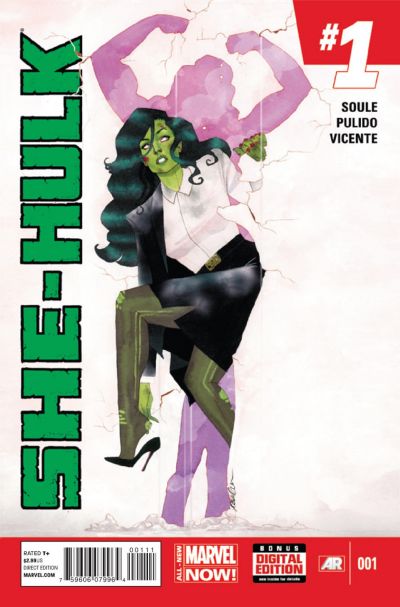 volume for its entire twelve issue run with Javier Pulido drawing all but two issues. The artistic design went for a slightly more experimental panel layout with a bold vibrant color pallet. The style could be described as cartoony and less expressive, but worked to balance the slightly more serious tone of the writing. Muntsa Vicente provided soft watercolor covers that really stood out and emphasized the lawyer aspect of the series as opposed to the silliness or sexiness of past covers. For the plots, the lawyer background of Soule was really on display, as believable legalese was often and profusely utilized in every issue. Often, a nearly overwhelming amount of speech bubbles would crowd the pages but never at the expense of the story or art. While the book was not humorless, Jen’s work was taken seriously and she was often portrayed as highly competent in her job and as a hero. Romance was not a focus of this series but it did do quite a bit in developing her friendships with fellow heroes.
volume for its entire twelve issue run with Javier Pulido drawing all but two issues. The artistic design went for a slightly more experimental panel layout with a bold vibrant color pallet. The style could be described as cartoony and less expressive, but worked to balance the slightly more serious tone of the writing. Muntsa Vicente provided soft watercolor covers that really stood out and emphasized the lawyer aspect of the series as opposed to the silliness or sexiness of past covers. For the plots, the lawyer background of Soule was really on display, as believable legalese was often and profusely utilized in every issue. Often, a nearly overwhelming amount of speech bubbles would crowd the pages but never at the expense of the story or art. While the book was not humorless, Jen’s work was taken seriously and she was often portrayed as highly competent in her job and as a hero. Romance was not a focus of this series but it did do quite a bit in developing her friendships with fellow heroes.
The series began with Jennifer once again being fired/quitting a law practice, this time for failing to bring in her superhero friends as new clients. Jennifer knew her value was more than her 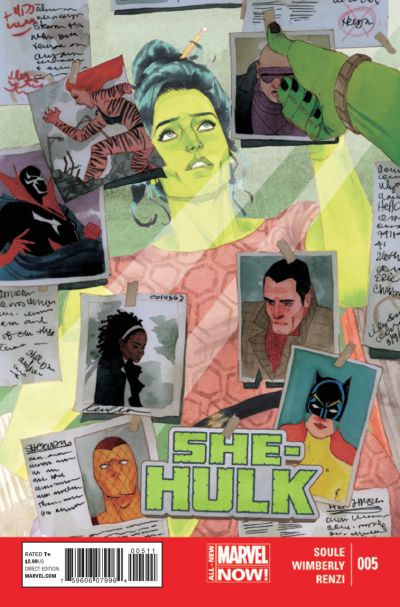 connections and decided she should begin her own practice. Her first client was Holly Harrow, the widow of villainous scientist Jonas Harrow. She wanted to sue Tony Stark over a patent owned by her late husband and She-Hulk managed to settle with Tony out of court for a sizable payout. Her generous fee from this case helped fund her opening her own law practice office in a building that housed various super-people. To fill out her staff, she hired the mysterious and weird paralegal Angie Huang, who always had her Capuchin monkey on hand. She also brought on her friend Patsy Walker (aka Hellcat) as an investigator. She would occasionally reach out to fellow superhero lawyer Matt Murdock for legal advice.
connections and decided she should begin her own practice. Her first client was Holly Harrow, the widow of villainous scientist Jonas Harrow. She wanted to sue Tony Stark over a patent owned by her late husband and She-Hulk managed to settle with Tony out of court for a sizable payout. Her generous fee from this case helped fund her opening her own law practice office in a building that housed various super-people. To fill out her staff, she hired the mysterious and weird paralegal Angie Huang, who always had her Capuchin monkey on hand. She also brought on her friend Patsy Walker (aka Hellcat) as an investigator. She would occasionally reach out to fellow superhero lawyer Matt Murdock for legal advice.
While the focus of the series was on the lawyer aspect of She-Hulk, she still inevitably found herself punching villains in every issue. Her first big case involved trying to obtain asylum for Kristoff von Doom, who just wanted to be his own man outside of the shadow of his father Dr. Doom. She also teamed up with Daredevil and Hank Pym for a couple superhero adventures and was asked by Steve Rogers to defend him against a charge of wrongful death back in World World II. This led to a three issue arc in which a period of Steve’s past was dissected by She-Hulk’s defense and Matt Murdock’s prosecution. This first courtroom head to head of Marvel’s two most prominent lawyers turned out to be orchestrated by none other than Steve himself. He had asked Matt to do his best to prove himself guilty in order to make sure he was not at fault. He entrusted Jennifer to be his defense because he knew she would find the answers to absolve him in the public eye, even if Steve knew one of his villains was behind the smear job.
The major mystery throughout the whole twelve issue run was the Blue File. A North Dakota man named George Saywitz had sued a group of seemingly unrelated superheroes and villains including She-Hulk, but none of the defendants recalled the events detailed in the lawsuit. When 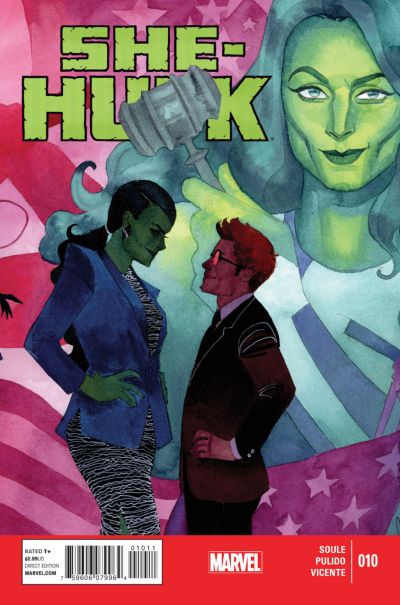 She-Hulk’s team split up to investigate the file, the defendants they found seemed to become mind-controlled at the mention of Saywitz. This led to Hellcat’s hospitalization and Angie being shot in the head. However, Angie somehow revived through the actions of her monkey. Finally, Nightwatch, another of the heroes named in the suit, visited Jen’s office and helped fight off a horde of demons. The file was put on the back-burner due to the danger until the end of the series when Titania showed up to fight She-Hulk, having been hired by the one behind the blue file events. Angie revealed that she had still been investigating and that Nightwatch was the one responsible, even placing a "geas" on She-Hulk to lose interest after the demon attack. He used to be a villain but had used the North Dakota town as a mystical sacrifice to brainwash the world into thinking he had always been a minor superhero. That way he could absolve his villainous background but remain in the minor leagues of heroes, off the radar. The only witness with any memory was George Saywitz who was killed shortly after filling the lawsuit. During the climatic fight that broke out, She-Hulk became mind-controlled but was saved by the unexplained powers of Angie and her flying, super-strong monkey. The whole affair ended with Nightwatch captured and Jen’s practice choosing to stay together.
She-Hulk’s team split up to investigate the file, the defendants they found seemed to become mind-controlled at the mention of Saywitz. This led to Hellcat’s hospitalization and Angie being shot in the head. However, Angie somehow revived through the actions of her monkey. Finally, Nightwatch, another of the heroes named in the suit, visited Jen’s office and helped fight off a horde of demons. The file was put on the back-burner due to the danger until the end of the series when Titania showed up to fight She-Hulk, having been hired by the one behind the blue file events. Angie revealed that she had still been investigating and that Nightwatch was the one responsible, even placing a "geas" on She-Hulk to lose interest after the demon attack. He used to be a villain but had used the North Dakota town as a mystical sacrifice to brainwash the world into thinking he had always been a minor superhero. That way he could absolve his villainous background but remain in the minor leagues of heroes, off the radar. The only witness with any memory was George Saywitz who was killed shortly after filling the lawsuit. During the climatic fight that broke out, She-Hulk became mind-controlled but was saved by the unexplained powers of Angie and her flying, super-strong monkey. The whole affair ended with Nightwatch captured and Jen’s practice choosing to stay together.
| Writers | Artists |
|---|---|
|
|
Captain America and the Mighty Avengers – (2015)
This title was a sequel title to the Luke Cage led Mighty Avengers (Vol 2). She-Hulk continued her membership under their new leader Sam Wilson, who had recently taken on the mantle of Captain America. She-Hulk was really just a team player and was largely in the background. Her one major contribution to the team was during the AXIS event, when Luke Cage was inverted into a profit obsessed man ready to sell the rights to the team. In the previous volume, She-Hulk had set up the company to be equally financially controlled by all members, preventing a unilateral decision by any one person. Other than this moment, she mostly just used her muscle to help fight the Beyond Corporation with more plot being focused on Photon and Blue Marvel. The title ended quickly with a tie into the Last Days of Time Runs Out, leading up to Secret Wars.
| Writers | Artists |
|---|---|
|
|
A-Force (2nd series) – (2016)
After the success of several ideas during 2015’s Secret Wars line-wide crossover, one of the new titles to spin out into an ongoing series was A-Force. In the original mini-series, just about every female superhero lived on a Utopian domain of Battleworld called Arcadia. A new character Singularity was introduced in that series and managed to escape the destruction of Battleworld into the 616 Universe but was pursed by an energy being named Antimatter, whose sole focus was her capture. Singularity used her teleportation powers to find her “friends,” including former head of Arcadia She-Hulk. Jennifer had no idea who she was but refused to let the creature destroy this girl. The team that would eventually be named A-Force and be led by She-Hulk included Singularity, Nico Minoru, Medusa, Captain Marvel and Dazzler. The first four issues which formed the team and resolved the Antimatter plot were written by the original mini-series writer G. Willow Wilson with help from Kelly Thompson. However, Thompson took over full writing duties for the remaining six issues of the series.
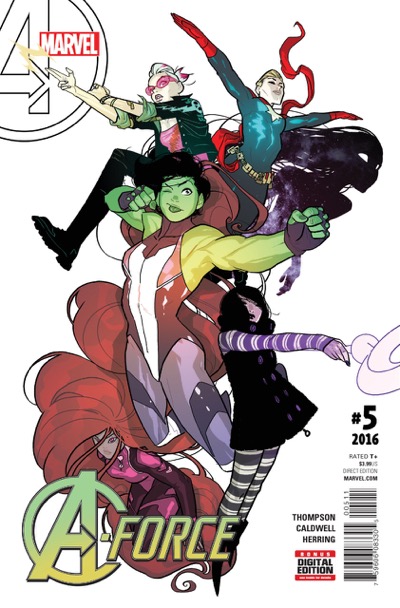 Notable plot points involving She-Hulk included her natural fit for team leader, despite opposition from strong personalities like Medusa and Captain Marvel. She also managed to appeal to the hearts of the team with her refusal to give up on her teammates, including when the magically villainous Countess possessed Nico. During this confrontation, Nico caused Jennifer to go savage and attack her teammates, though they were luckily able to subdue her. The final three issues of the series was a crossover with Civil War II in which Captain Marvel and Medusa wanted to use an inhuman with perfect future crime prediction for the good of everyone. A-Force was conflicted about this predictive justice especially since their leader She-Hulk was put into a coma by Thanos at the start of the conflict. Unfortunately, Jen had not recovered by the end of the series and A-Force broke up off panel.
Notable plot points involving She-Hulk included her natural fit for team leader, despite opposition from strong personalities like Medusa and Captain Marvel. She also managed to appeal to the hearts of the team with her refusal to give up on her teammates, including when the magically villainous Countess possessed Nico. During this confrontation, Nico caused Jennifer to go savage and attack her teammates, though they were luckily able to subdue her. The final three issues of the series was a crossover with Civil War II in which Captain Marvel and Medusa wanted to use an inhuman with perfect future crime prediction for the good of everyone. A-Force was conflicted about this predictive justice especially since their leader She-Hulk was put into a coma by Thanos at the start of the conflict. Unfortunately, Jen had not recovered by the end of the series and A-Force broke up off panel.
| Writers | Artists |
|---|---|
|
|
 Hulk (4th series) / She-Hulk (1st series) – (2017-2018)
Hulk (4th series) / She-Hulk (1st series) – (2017-2018)
For the first time, a female writer took on She-Hulk’s solo series for an extended run. Mariko Tamaki wrote the series for 16 issues, the first 11 of which were titled Hulk and the final five issues reverting to the legacy numbering and title of She-Hulk. Because of several of their big titles hitting big milestones, Marvel began a line-wide initiative to revert most Marvel titles back to their original numbering, adding up all of their series to that point. See below for the math used to determine She-Hulk’s legacy numbering.
| She-Hulk Solo Titles | Legacy Numbering |
|---|---|
| Savage She-Hulk #1-25 | #1-25 |
| Sensational She-Hulk #1-60 | #26-85 |
| She-Hulk (1st series) #1-12 | #86-97 |
| She-Hulk (2nd series) #1-38 | #98-135 |
| She-Hulk (3rd series) #1-12 | #136-147 |
| Hulk (4th series) #1-11 | #148-158 |
| She-Hulk (1st series) #159-163 | #159-163 |
Mariko had a history of writing on topics of identity, depression and grief, so the direction that she 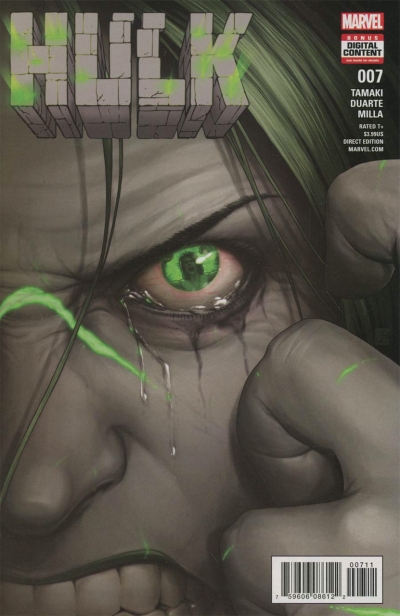 took Jennifer in her new series fit this pattern. The tone that was established felt very raw, honest and believable for someone going through depression due to a traumatic experience. In this story, that trigger of depression resulted from the events of Civil War II in which Thanos put She-Hulk into a near death coma, followed by the execution of her cousin Bruce Banner. At the start of the series, it was clear that Jennifer was not emotionally well and was struggling mentally to return to some version of normalcy. She did this by returning to a standard law firm job and watching online baking shows to calm herself when her emotions feel on the verge of boiling over. She also received emotional support throughout the series from her best friend Patsy Walker and a trauma support group.
took Jennifer in her new series fit this pattern. The tone that was established felt very raw, honest and believable for someone going through depression due to a traumatic experience. In this story, that trigger of depression resulted from the events of Civil War II in which Thanos put She-Hulk into a near death coma, followed by the execution of her cousin Bruce Banner. At the start of the series, it was clear that Jennifer was not emotionally well and was struggling mentally to return to some version of normalcy. She did this by returning to a standard law firm job and watching online baking shows to calm herself when her emotions feel on the verge of boiling over. She also received emotional support throughout the series from her best friend Patsy Walker and a trauma support group.
The first arc constituted six issues and focused on Jennifer attempting to help a super-powered and fellow trauma survivor named Maise from being evicted from her apartment. As Jennifer investigated, people that threatened Maise end up mysteriously murdered. This culminated in issue six, in which Jennifer confronted Maise with the fact that the building had been sold and there was nothing she could do to prevent the eviction. When Maise manifested a monster to punish Jen, she transformed into the Hulk, a savage, grief-induced, gray version, for the first time in the series. This marked one of the many drastic departures from previous runs in which Jennifer was terrified to turn into the Hulk, paralleling the traditionally Bruce-centered stories and justifying the change of the title and character to simply Hulk.
The second arc further explored self-acceptance of one’s monstrous side, as well as the feelings of being a victim. When Jennifer was watching her baking show, the host Oliver transformed 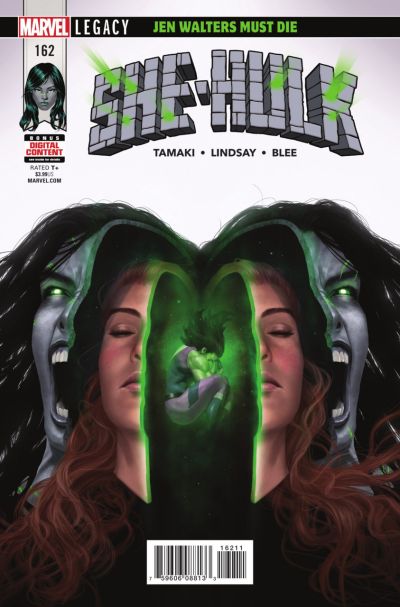 against his will into a monster, resulting from drugs planted by his camera operator. Jennifer felt compelled to find and help Oliver with the assistance of Patsy and Oliver’s boyfriend. The conflict ended with a fight between Hulk and Oliver in which Patsy talked down Hulk from killing Oliver, further terrifying Jen of the consequences of her transformation. The final arc of the series involved a mega-fan named Robyn kidnapping Jennifer with the intention of figuring out the reason for her recent changes. Robyn was being manipulated by the Leader and she ended up giving herself a transfusion of Jennifer’s blood in order to turn herself into a Hulk. Hulk managed to take down Robyn and the Leader but, afterwards, decided to get serious psychological help from her trauma counselor. After analyzing her innermost self, she was able to overcome her fear and grief in order to turn back into her green She-Hulk form. The series ended with her quitting the law firm over differences in opinion on her casework but with an optimistic look on her future.
against his will into a monster, resulting from drugs planted by his camera operator. Jennifer felt compelled to find and help Oliver with the assistance of Patsy and Oliver’s boyfriend. The conflict ended with a fight between Hulk and Oliver in which Patsy talked down Hulk from killing Oliver, further terrifying Jen of the consequences of her transformation. The final arc of the series involved a mega-fan named Robyn kidnapping Jennifer with the intention of figuring out the reason for her recent changes. Robyn was being manipulated by the Leader and she ended up giving herself a transfusion of Jennifer’s blood in order to turn herself into a Hulk. Hulk managed to take down Robyn and the Leader but, afterwards, decided to get serious psychological help from her trauma counselor. After analyzing her innermost self, she was able to overcome her fear and grief in order to turn back into her green She-Hulk form. The series ended with her quitting the law firm over differences in opinion on her casework but with an optimistic look on her future.
| Writers | Artists |
|---|---|
|
|
Avengers (7th series) – (2017-2022)
Jason Aaron’s long stint on the seventh Avengers series had a base roster of the arguably core Avengers that were heavily featured in the Marvel Cinematic Universe and a rotating cast of other less traditional members. She-Hulk (going by just Hulk at the time) and the Jaime Reyes Ghost Rider joined Captain America, Iron Man, Thor, Captain Marvel and Black Panther. The starting arc also saw Doctor Strange helping but he was quickly replaced by Blade. Jennifer was mostly the muscle throughout the multiple arcs, but a few story points stood out.
In the beginning, Jennifer was clearly still recovering from her emotional trauma seen in her last solo title. However, after a major overdose of radiation while battling Celestials in the first team building arc, her powers majorly increased to around the same levels of Bruce Banner Hulk. This also came with a decrease in her mental faculties and speech pattern, making her a clear stand-in for a traditional Hulk personality often seen in the movies. Due to this rather significant change, much of the more nuanced emotions seen in the most recent stories were pretty much ignored going forward. Additionally, Hulk and Thor had an obvious physical attraction and the two started a relationship. Issue #11 had Thor take Jennifer on a date to the Savage Land in which it became obvious there was no chemistry with Hulk’s human self but, once transformed, Hulk could not keep her hands off him. This further demonstrated one of the uncommon times that a significant personality difference existed between her two sides.
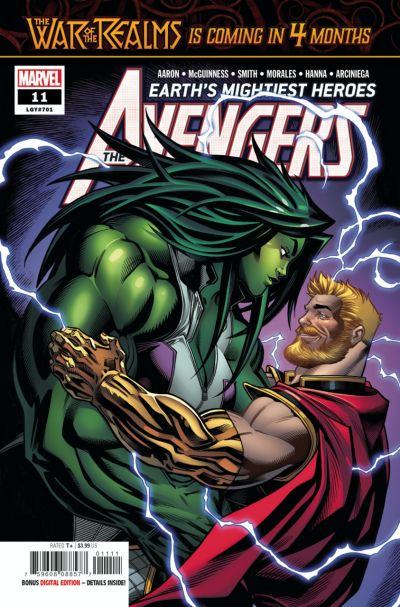 Hulk established a bit of a grudge with Namor during this run when the team fought him in the second arc. She also became a reliable workhorse during the prolonged and global War of the Realms, where she constantly warped to areas of conflict as the cavalry. After these first 20 or so issues, Jen fell into the background a bit, helping the team but not getting a lot of focus. However, during the Empyre event, the invading Cotati killed She-Hulk and took over her body. In the one-shot Immortal She-Hulk, it was explained that all gamma mutated characters were tied to the Green Door and were basically immortal. These themes were tied to Al Ewing’s Immortal Hulk run and retconned Jennifer’s origin and other past near-death experiences as actual deaths from which she resurrected, thanks to her gamma exposure. Using this new ability, She-Hulk was able to return to life through the Green Door and fight off the Cotati corruption.
Hulk established a bit of a grudge with Namor during this run when the team fought him in the second arc. She also became a reliable workhorse during the prolonged and global War of the Realms, where she constantly warped to areas of conflict as the cavalry. After these first 20 or so issues, Jen fell into the background a bit, helping the team but not getting a lot of focus. However, during the Empyre event, the invading Cotati killed She-Hulk and took over her body. In the one-shot Immortal She-Hulk, it was explained that all gamma mutated characters were tied to the Green Door and were basically immortal. These themes were tied to Al Ewing’s Immortal Hulk run and retconned Jennifer’s origin and other past near-death experiences as actual deaths from which she resurrected, thanks to her gamma exposure. Using this new ability, She-Hulk was able to return to life through the Green Door and fight off the Cotati corruption.
Around issue #40, she was one of many heroes chosen as a potential Phoenix Force host, competing in an elimination style fight tournament. During this  conflict, she managed to go all out against competitor Namor in the middle of Moscow but, before a victory could be decided, they were interrupted by the chosen avatar Echo. The final arc involving Hulk that ran through issue #50 was titles World War She-Hulk, in which she was kidnapped by the Russian Winter Guard and brainwashed. The torture she endured turned her skin red and she was renamed Winter Hulk. After fighting the Avengers, it appeared that Hulk was on the verge of setting off a nuclear blast in order to disintegrate Namor’s Atlantis. However, her defection turned out to be a ruse, and Hulk saved Atlantis and took out the Russian Red Room. These efforts overtaxed her and caused her to explode off all of her excess radiation, returning her to her normal Sensational self. Before she left the team, she requested that Namor take her place as an appreciation for saving Atlantis and officially ending the grudge between them.
conflict, she managed to go all out against competitor Namor in the middle of Moscow but, before a victory could be decided, they were interrupted by the chosen avatar Echo. The final arc involving Hulk that ran through issue #50 was titles World War She-Hulk, in which she was kidnapped by the Russian Winter Guard and brainwashed. The torture she endured turned her skin red and she was renamed Winter Hulk. After fighting the Avengers, it appeared that Hulk was on the verge of setting off a nuclear blast in order to disintegrate Namor’s Atlantis. However, her defection turned out to be a ruse, and Hulk saved Atlantis and took out the Russian Red Room. These efforts overtaxed her and caused her to explode off all of her excess radiation, returning her to her normal Sensational self. Before she left the team, she requested that Namor take her place as an appreciation for saving Atlantis and officially ending the grudge between them.
| Writers | Artists |
|---|---|
|
|
She-Hulk (4th series) – (2022 - present)
 Novelist Rainbow Rowell’s take on She-Hulk involved a fair amount of humor and a whole lot of romance. Rainbow’s still-developing plots demonstrate an extensive knowledge of She-Hulk’s continuity, referencing events throughout her publication history, including even a short story where she left in the middle of a Supreme Court case. Jack of Hearts came back into her life without any knowledge of where he had been or why he was now powerless. The events of their time together on the Avengers was often referenced, as the two were cautious of touching each other for fear of destabilization, though the chemistry slowing bubbling over several issues very much implied they wanted to touch each other. This tension finally climaxed issue #6 when the two gave into their passions.
Novelist Rainbow Rowell’s take on She-Hulk involved a fair amount of humor and a whole lot of romance. Rainbow’s still-developing plots demonstrate an extensive knowledge of She-Hulk’s continuity, referencing events throughout her publication history, including even a short story where she left in the middle of a Supreme Court case. Jack of Hearts came back into her life without any knowledge of where he had been or why he was now powerless. The events of their time together on the Avengers was often referenced, as the two were cautious of touching each other for fear of destabilization, though the chemistry slowing bubbling over several issues very much implied they wanted to touch each other. This tension finally climaxed issue #6 when the two gave into their passions.
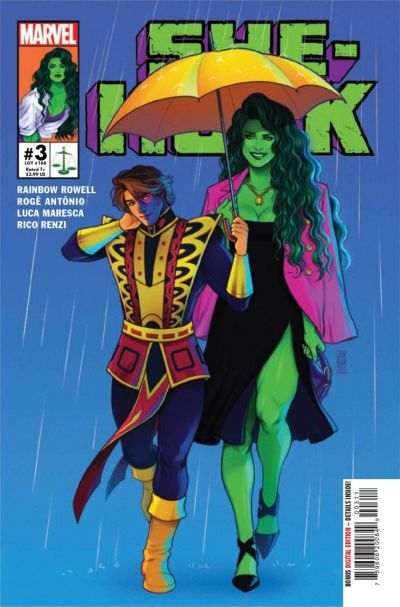 Outside of the romance focus, She-Hulk went back to Mallory Book (dating Awesome Andy again) for a lawyer job but quickly failed to attract non-super-hero clients as requested. While annoyed at first, Book quickly changed her mind after Nightcrawler requested that She-Hulk become the lawyer for the entire mutant nation of Krakoa. Additionally, Rainbow got the practically required Titania fight out of the way in the first issue with the two rivals agreeing to a mutual fight club of sorts for fun. It is unclear at which point this series fits into the events of Dan Slott’s Fantastic Four run. In that title, the Reckoning War long hinted at in his She-Hulk run finally occurred and She-Hulk and Jack of Hearts helped to restore an additional 90% of the universe. Jack of Hearts seemingly gave his life to help protect Jen and the rest of the universe but ended up surviving. It remains to be seen if these events will affect the current She-Hulk series.
Outside of the romance focus, She-Hulk went back to Mallory Book (dating Awesome Andy again) for a lawyer job but quickly failed to attract non-super-hero clients as requested. While annoyed at first, Book quickly changed her mind after Nightcrawler requested that She-Hulk become the lawyer for the entire mutant nation of Krakoa. Additionally, Rainbow got the practically required Titania fight out of the way in the first issue with the two rivals agreeing to a mutual fight club of sorts for fun. It is unclear at which point this series fits into the events of Dan Slott’s Fantastic Four run. In that title, the Reckoning War long hinted at in his She-Hulk run finally occurred and She-Hulk and Jack of Hearts helped to restore an additional 90% of the universe. Jack of Hearts seemingly gave his life to help protect Jen and the rest of the universe but ended up surviving. It remains to be seen if these events will affect the current She-Hulk series.
| Writers | Artists |
|---|---|
|
|
